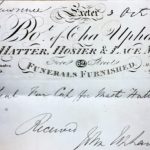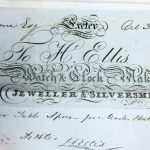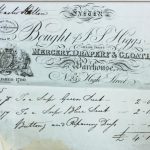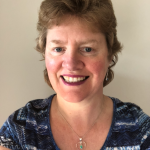Charles Benjamin Hutton was born on 9 August 1817 at Bartholomew Terrace, Heavitree, Devonshire, England. He was the child of Benjamin Charles Hutton, a gentleman, (1789-1820) and Maria Pearce Rowe (1785-1817). Sadly, Maria died in childbirth with Charles and was buried on 19 August at St Mary Steps, Exeter aged 32.
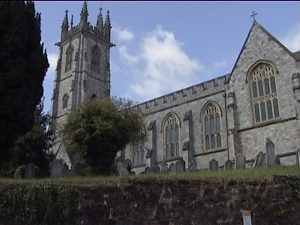
St Michael and All Angels Heavitree Devon
Charles was baptised on 6 October 1817 at the church of St Michael and All Angels, in Heavitree.
His father Benjamin was left to raise Charles alone, and his siblings Charlotte (1811-1895), Mary (1814-1902) and Elizabeth (1815-1885).
Sadly however his father Benjamin died only three years later in July 1820 when Charles was only two. He was buried at the church of the Holy Trinity, Exeter.
Fortunately, the family were very wealthy and it appears his mother’s relatives the Pierce and Northmore families took care of the children.
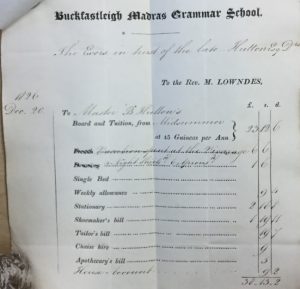
Charles B Hutton Buckfastleigh Grammar School account 1826
Charles was educated at a boys boarding school, Madras Grammar School in
Buckfastleigh, Devon with money left by the executor of his father’s will Northmore Laurence. In 1826 Northmore Laurence paid 39 pounds for his board and tuition.
A number of accounts were then sent to Mr Laurence from the school for reimbursement such as – night shirts and aprons, a weekly allowance, stationary, the shoemakers bill, socks, handkerchiefs, tailors bill, chaise hire, apothecary’s bill and house account.
An account from the local tailor lists clothes bought for Charles – a green suit, a blue suit and a silver table spoon from the Jeweller and silversmith. (Click to view).
- Hatters account
- Jewellers account
- Drapers account
Other items include a two foot trunk, nailbrushes, combs, and a seal fur cap from the Hatter.
A letter of how he conducted himself at school was also included saying that “his fit of inaction has been of short continuance and of less frequent occurrence than they were and his health was very good.”
A later school report says he is continuing steadily and is a very good boy in house and in school. his health was excellent and he is always in high spirits. A further account asks for reimbursement of a fur cap, new trunks, a silver spoon, combs, brushes, purse, cutting hair, pocket money, etc. Charles vacation was spent at the Buckfastleigh vicarage.
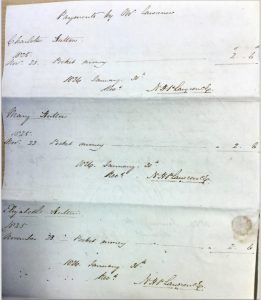
Charlotte, Mary and Elizabeth Hutton’s boarding school account 1826
The children’s grandfather Charles Pierce, paid for the education of the girls (via his will) – Mary, Elizabeth and Charlotte at Myrtle Hill, Tynemouth, Devon.
In 1826 an account was sent to Mr Northmore Herle Pierce Lawrence for the three girls in November 1825, for pocket money.
The girls accounts included an inventory for instruction in dancing, french and music, writing, fancy articles, hair cutting, long gloves, use of piano and practice, pens and slate pencils, drawing pencils, copy books, brown paper, sacred poetry.
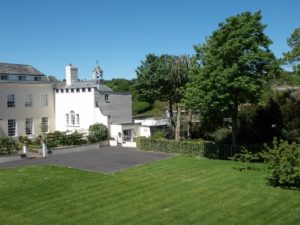
Cleve House, home of Charlotte Hutton in 1838
Charles’ sister, 26 year old Charlotte, was married off (by license) in 1838 in St Thomas, Devon, to a wealthy widower gentleman 59 year old Lieutenant Colonel William Downes Phillott (1778-1859). William had seven children by his previous wife Henrietta Phillips.
At the time she was living at 17th century built manor house “Cleve House”, Exwick Lane, Exeter, home of the Thomas Northmore family (her ancestors).
Charles’ other two sisters, Mary and Elizabeth didn’t marry. In 1861 widowed Charlotte is living with her two sons in Teignmouth, Devon.
Later the three sisters were living together in the 1871 census in St Sidwell, Exeter (Charlotte was widowed in 1859). They are all three described as fundholders (income derived from Dutch Funds).
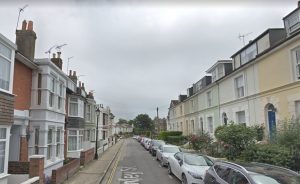
Charlotte Hutton 1881 census Stanley Street Portsea England
Charlotte and Elizabeth can be found still together in the 1881 census of Portsea, Hampshire (lodging with the Smith family at Stanley Street, 13 Claremont Terrace).
The whole street is lined with beautifully kept terrace houses.
By the time Charles was 18 he was living at Launceston, Cornwall and was bound to a solicitor to begin his Articles of Clerkship (studying to be a lawyer). Trainees were obligated to sign a contract agreeing to the terms of being an articled clerk. The articled clerk signs a contract, known as “articles of clerkship”, committing to a fixed period of employment.
Charles was bound by a deed dated 2nd March 1835, to his mother’s relative’ s Northmore Herle Pierce Lawrence (his mother was Maria Pierce), an attorney at the Kings Bench at Westminster Hall and a solicitor of His Majesty’s High Court of Chancery.
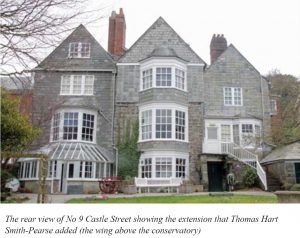
Charles Hutton 9 Castle Street Launceston
Charles was now working at 9 Castle Street, Launceston. In 1837 he applied for a game license (hunting license).
24 year old Charles appears in the 1841 census living in Little Marshall, Ide, Devon with his sister Charlotte and two of her husband’s children from his first marriage – Daniel and Henrietta.
One year later, 25 year old Charles decided to leave his native land, and immigrate to Melbourne, Australia. There is a shipping record for a Charles Hutton and family, cabin passengers aboard the “Andromache” from Plymouth on 13 February 1842. This may be our Charles.
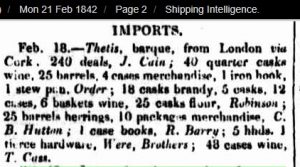
Charles B Hutton importing goods on Thetis Feb 1842 Trove
I also found a notice in the Port Phillip Patriot and Melbourne Advertiser newspaper for 21 February 1842, advising of goods of Import for C B Hutton, which I’m guessing are his belongings from England.-
All we know for certain is that Charles Hutton was definitely in Melbourne by 1842, as he he is mentioned in the 1867 book “Victorian Pioneers who signed the Loyal Address to Duke of Edinburgh” – Hutton, C B who arrived Aust Feb 14, 1842, which seems to confirm the above.
In 1846 Charles served on a jury for a coroners inquest held on the body of Mr William Urquart in Melbourne.
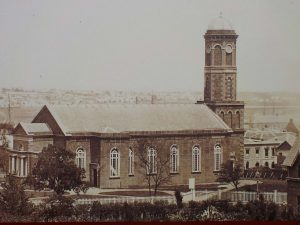
St James Old Cathedral Melbourne
Charles Benjamin Hutton married Irish lass Eliza McSweeney on 24 Feb 1846 at St James Church of England, Melbourne.
The St James parish register states they were previously unmarried, and they were married by license (not banns) suggesting they wanted a quick marriage, or didn’t want to call the banns over three Sundays previously for some reason.
Witnesses to the marriage were John O’Connell and Margaret Coffey of Melbourne. I can’t find a birth or burial of a child until two years after their marriage in 1848.
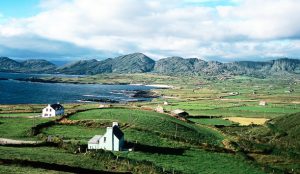
Cork Ireland
Not a lot is known about Charles’ wife Eliza McSweeney other than she was born around 1822 in Cork Ireland.
I have a DNA match to another McSweeney family from Boherbue, Cork descended from her possible sister Mary McSweeney who was born in 1827 in Boherbue.
Mary married Thomas Clifford and had five children (Julia, Elizabeth, Bridget, Mary and Denis).
In June 1846, just after he was married, Mr Charles Benjamin Hutton appeared before the Mayors Court in the city of Melbourne claiming that Mr Charles Banbury had destroyed a document, his property. He claimed on 30 March that he and his wife entered a property holding an agreement document regarding his lodging arrangements and that Mr Banbury destroyed the document. Costs were awarded to Mr Hutton.
The following year in 1847 Charles appears in the Port Phillip Almanac as a Clerk off Collins Lane, Melbourne.
In 1848 he appears in the newspaper as a “Bailiff to the Plaintiff” his client a Mr William Turner, Tailor and Draper, in an auction of drapery goods for a client, under distress of rent.
In January 1849, Mr C B Hutton was re-elected to the office of Treasurer of the Melbourne Building Society according to the advertisement in the Port Phillip Gazette and Settlers Journal.
Building societies were first established in provincial England towards the end of the 18th century as a way of encouraging thrift and home-ownership among working men.
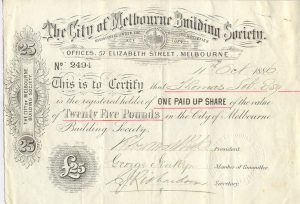
Melbourne Building Society Share certificate 1886
By pledging themselves to regular contributions, the members of the society accumulated the funds for borrowers to embark on the purchase of their own modest dwellings.
Sometimes members took turns to take a loan, casting lots for the privilege, until all the members had taken and repaid their loan when the society was ‘terminated’, usually after five to seven years. Since freeholders also qualified for the vote, building societies were regarded as a force for political emancipation. In the colonies they also became an ideal vehicle for land speculation.
The land-hunger that propelled the Free Selection movement also inspired Melbourne’s self-improving shopkeepers and artisans to acquire suburban homes of their own. By the 1870s building society membership was more than twice as high per capita as in England.
Charles and Eliza had seven children –
- 1848 William Charles b Collingwood d 1858 Nunawading – drowned aged 10
- 1849 Pierce b Melbourne d 1920 Brunswick married Rachel Sperin
- 1851 Frederick b Richmond d 1894 Collingwood married Arthena Coulton
- 1853 Arthur b Melbourne d 1898 Melbourne East married Jane Crispin
- 1855 Charles B b Nunawading d 1927 Castlemaine married Ellen Stracey
- 1858 William Charles b East Collingwood d 1930 Northcote
- 1862 Alfred b Collingwood d 1903 Collingwood married Asenath Jennings
In February 1850 Charles is mentioned again in The Argus newspaper as being a candidate for the position of secretary of the Union Benefit Building and Investment Society.
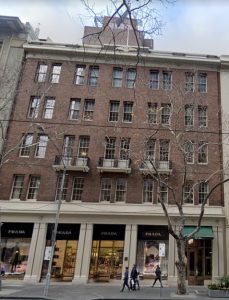
79 Collins Street Melbourne (now Prada) – 1852 office of C B Hutton
By September 1850 he states he placed a notice in the Melbourne Daily News that he is working for a client, and that people indebted to the estate of a client Mr F E Paynter should forward their respective amounts to Mr C B Hutton of 79 Collins Street East.
Charles then appears to get himself in some financial difficulties and he appears in the newspaper and other documents several times. In November 1851 a ‘Dissolution of Business’ notice appeared for him and partner James Walker (Victorian Government Gazette).
In 1851 he is recorded on the Electoral Roll for Port Phillip as having a dwelling house in Collins Street, and the following year in 1852 he is granted an auctioneer’s license. He is now working as a house sale agent, auctioneer and law clerk.
Over the next few years in the 1850s hundreds of advertisements appear in the Melbourne newspapers advertising public auctions around Melbourne and surrounds, mostly under the name of C.B.Hutton.
Sometimes he is working with Mr James Walker, and they announce themselves as General Commission Agents and Collectors at 79 Collins Street.
In 1853 he placed a large advertisement in the newspaper stating he was removing his business of a land and Estate Agent from Collins Street to 35 Elizabeth Street.
He states he has an extensive registry of properties for sale and to let, which are open for inspection.
Charles appears in the 1854 Commercial and Squatters Directory of Melbourne – Elizabeth Street west side where Flinders Lane intersects, 35, Hutton C.B. auctioneer.
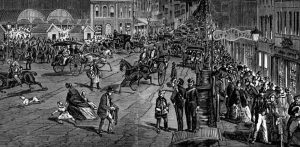
Early Melbourne
In February 1855 he signs a subscription list, advertised in the Argus for the Fund for Making Metalling and Improving of Smith Street from Victoria Parade to Heidelberg Road. He paid a subscription fee of 3 pounds along with many other residents.
Sometime before 1855 Charles moves the family from the city of Melbourne out to a farm at Nunawading, which is where his son (his namesake) was born in November 1855.
In 1855 poor Charles suffers a major blow to his health, and finds himself back in the Insolvency court.
A notice appears in the Argus newspaper for Monday 10 December 1855 stating Charles Benjamin Hutton of Nunawading, auctioneer is now out of business with large debts. The cause of insolvency is given as a depreciation of the property, a long illness and a paralytic affection causing permanent deafness.
The move to Nunawading becomes a fateful one, when his oldest son William is found drowned, aged only 10 in 1858.
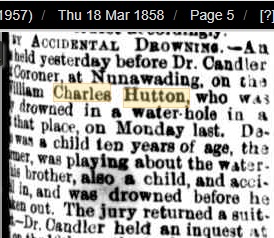
William Charles Hutton drowned aged 10 1858
William had accidentally drowned when the children were playing together in a fenced off 14 foot round waterhole in their father’s farm paddock at Nunawading.
His brother Pierce gave a statement at the coroners inquest in which he saw his brother lose his footing and slip under the water.
After the death of his son the family moved back to the city, to Collingwood, and in Mar 1858 Charles’ house and grocer shop, tenanted by Mr Robert Wynne in Richmond Road was sold as part of his insolvent estate. Also a cottage in Sherwood Street was sold.
In 1859 Charles appears in a trade directory as a house and commission agent at 216 Wellington Street, Collingwood (Tanners 1859 Melbourne directory). He is also placing advertisements for property sales from this address.
In 1859 his business address as changed to 2 Flinders Lane West and in the following year in 1860, Charles can be found practising as an Agent in the trade directory at the corner of 2 Flinders Lane and Cromwell Street in Collingwood (Sands and Kenny Directory).
Son Alfred is born in November 1862 while the family are living in Rupert Street, Collingwood, but things once again deteriorate financially the family when Charles made a bold move to improve their circumstances.
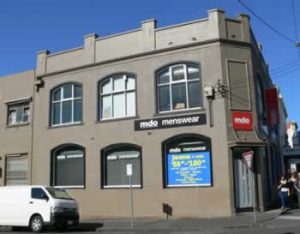
Vincents Hotel 390 Smith Street Collingwood Charles B Hutton 1863
In March 1863 he is once again in the Insolvency Court, living in Smith Street, Collingwood.
It seems he has purchased a hotel “Vincent’s Hotel” at 390 Smith Street, and has become a licensed victualler (innkeeper/publican).
It later became the Royal Hotel. (The hotel still stands and is now a commercial building).
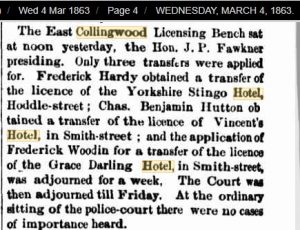
Charles B Hutton 1863 Argus transfer of license for Vincent’s Hotel
Mr Vincent lived on this site before the hotel was built, being a blacksmith and then a grocer before building a hotel.
The hotel was built and licensed in 1861 and was delicensed in 1919.
Charles obtained a transfer of license on 2 March 1863 for the hotel.
Unfortunately Charles must have only been operating a few weeks as he was back in the insolvency court, with the reason given as being persuaded to take Vincent’s Hotel under false pretences, loss by robbery and bad debts.
The property was therefore sold by public auction (ironic, given that he was an auctioneer) on 2nd April 1863, and all the goods were sold including 4 hogheads of ale, bottled port, wines, spirits, pewter pots, measures, glasses and sundries.
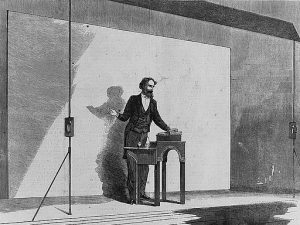
an auctioneer
In 1864 Charles Benjamin Hutton, gentleman, is paying rates on his residence on Cromwell Street, Collingwood and vacant land off Clarendon Place. He also owns property in Richmond.
In January 1868, Charles appears as a name mentioned on the Presentation of the Address of the Old Victorian Colonists presented to the Duke of Edinburgh. He appears as C.B. Hutton arrived February 17 1842.
In 1871 he is paying rates on a property, a wooden house, at 18 Dorset Street, Collingwood, owned by a Mr J B Hutton.
Charles passes away on 13 March 1873 at his home at 18 Dorset Street Collingwood. His death certificate states he is a lawyer, and that he died of phthisis (tuberculosis) at the age of 55. The informant was his son Pierce.
He is buried in the General Melbourne Cemetery on 14 March, with no headstone.
Eliza is left to raise the six boys on her own and the children were aged – Pierce 24, Frederick 22, Arthur 20, Charles 18, William 15 and Alfred 11.
Clearly it was a struggle for Eliza, and her son Arthur Hutton was to cause particular heartache to her when in 1871 at the age of 17 he was charged with unlawful assault and stealing and was arrested. He appears in the paper many times for larrikinism and petty theft, etc and in 1873 was convicted and sent to prison for breaking a window and obstructing the police.
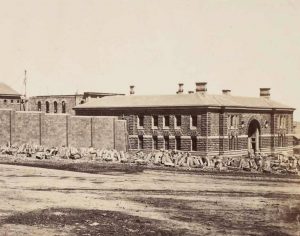
Old Melbourne Gaol
His prison record states he was 5ft 5, slight in weight, fresh complexion, brown hair, hazel eyes and that he was a bootmaker by trade (like his brother Alfred Hutton).
Arthur was sentenced to 3 months in Melbourne Gaol, which he served from 18 February 1873 to 3 May.
He seems to have straightened himself up and in 1882 he married Jane Crispin.
His brother Frederick Henry Hutton was also in trouble, and appeared in the East Collingwood Court in December 1870. Fred, a shoemakers apprentice was summoned by Mary Ann Bradley for refusing to maintain his illegitimate child (Matilda Hutton Bradley born 1870, died aged one in 1872).
It was proved he had been living with her for some time, and he was ordered to pay 5 shillings a week for 12 months. He was back in court in November 1871 named as a larriken throwing stones and threatening a constable. He was fined 5 pounds.
Fred went on to marry Arthena Coulton in 1882 and have six children.
His brother Pierce Hutton became a French Polisher in Collingwood, married Rachel Sperin and had seven children.
Another child Charles Benjamin Hutton (junior) was a general goods dealer at Rupert Street in Collingwood and Rathmine Street in Northcote. He married Ellen Stracey and had six children.
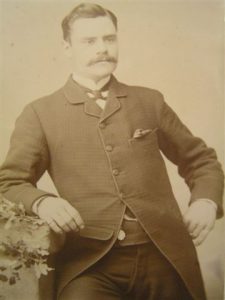
Alfred Hutton
Their brother William Charles Hutton was a carpenter and hawker in Collingwood and also lived in Rathmine Street Nothcote with his brother Charles.
The youngest son Alfred Hutton was a bootmaker in Collingwood and married Asenath Jennings, and had six children.
Charles’ wife Eliza continued to live in Dorset Street and appears in the rate books from 1873-1885 as owning the property. She died there on 16 May 1885 and was buried in the General Melbourne Cemetery with her husband in the Church of England section, Section K, No 106.
Eliza’s will stated she owned two properties at the time of her death, in Little Smith Street and Dorset street which she left to her children.

